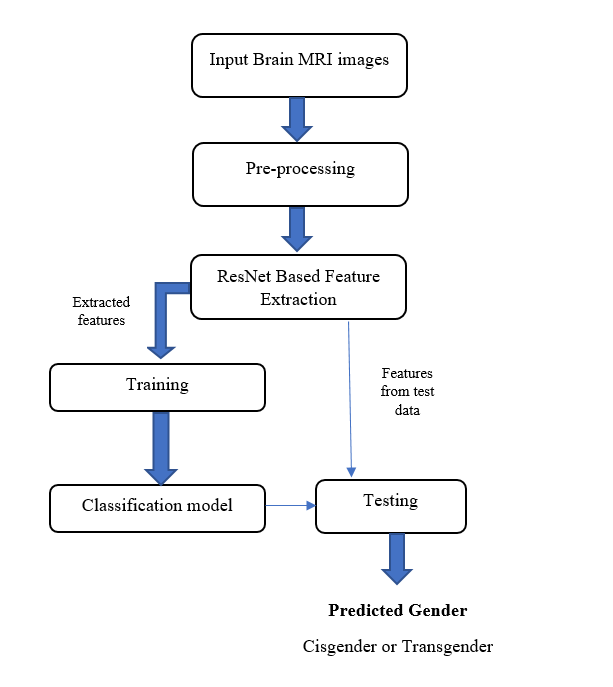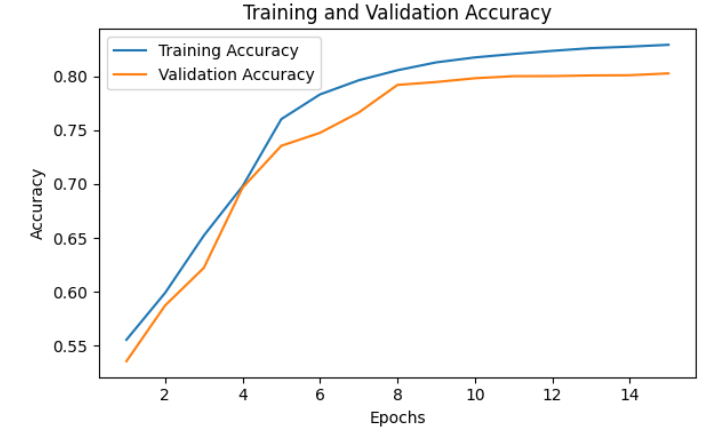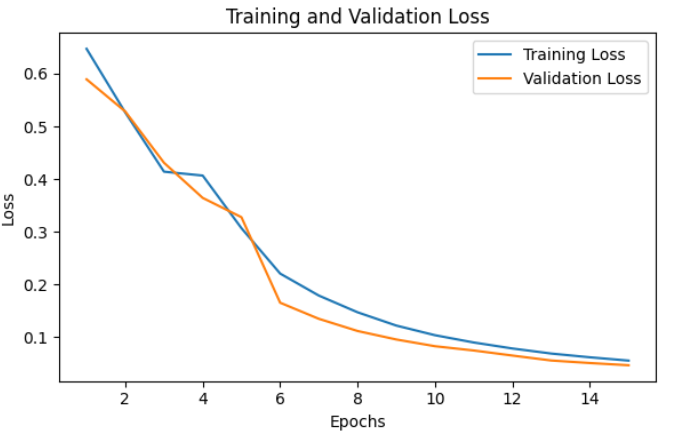Ijraset Journal For Research in Applied Science and Engineering Technology
- Home / Ijraset
- On This Page
- Abstract
- Introduction
- Conclusion
- References
- Copyright
Neuroimaging-Based Classification of Cisgender and Transgender Individuals Using MRI Brain Scans
Authors: Sreejakumari S, Arya J Nair, Sandhya S
DOI Link: https://doi.org/10.22214/ijraset.2024.64477
Certificate: View Certificate
Abstract
In recent years, the study of gender identity has considerably evolved, moving beyond binary definitions and embracing a more comprehensive understanding of the experiences of both cisgender and transgender people. In the middle of this advancement, neuroimaging and neuroscience present encouraging paths toward comprehending the biological foundations of gender identity. Magnetic resonance imaging (MRI) has become essential in studying brain anatomy and function, allowing scientists to investigate possible variations in the neuroanatomy linked to different gender identities. Here, cisgender and transgender classification from brain MRI scans using a Convolutional Neural Network is presented. With the use of these methods, the possibility of identifying unique brain traits that differentiate cisgender from transgender individuals is explored, which may provide insight into the biological components of gender identity.
Introduction
I. INTRODUCTION
Gender identity research has received much attention recently, particularly from psychologists, sociologists, and neuroscience experts. Understanding the complicated relationship between biology and identity is critical, especially when society recognizes the wide range of gender experiences. Transgender people are individuals whose gender identification differs from the sex given to them at birth, and they frequently strive to live in a way that is consistent with their true gender. Cisgender people, on the other hand, have gender identities that correspond to the sex they were assigned at birth. Although research examining brain differences between transgender and cisgender people is still in its early stages, several studies indicate that gender identity may be connected with neuroanatomical variances[1]. Gender is an authentic biomarker for individuals, providing constant insights into their biological and psychological characteristics. This consistency is critical for the clinical diagnosis of neurological and psychological disorders because it allows for more targeted treatments and interventions. As a result, gender identification research has become more important since it adds to a better knowledge of how gender impacts health outcomes and illness presentation.
Neuroimaging methods, notably magnetic resonance imaging (MRI), offer a unique perspective for researchers to investigate potential neuroanatomical variations related to gender identity. Convolutional neural networks (CNNs), a powerful technique in machine learning, have transformed image classification and analysis. Their capacity to recognize complex patterns in data makes them ideal for neuroimaging investigations, where tiny differences in brain anatomy may provide insights into the variations of both cisgender and transgender people. Using MRI brain pictures, this study uses the ResNet50 architecture to determine if a person is cisgender or transgender.
The ResNet50 model, noted for its depth and capacity to catch complex details, analyzes brain scans to uncover patterns associated with gender identification. The training uses a well-curated dataset of MRI scans, allowing the model to learn key characteristics for cisgender and transgender classifications. The categorization seeks to give insights into potential neurological distinctions, but findings should be treated with caution. Given the sensitive nature of employing neuroimaging for gender identity assessment, as well as the consequences for individual privacy and autonomy, ethical issues are crucial. Chapter 2 addresses various techniques for determining gender identity using brain imaging, highlighting known methods and their effectiveness. Chapter 3 describes the proposed classification system. The fourth chapter discusses the experimental data, evaluating the suggested approach's performance and accuracy. Finally, Chapter 5 summarizes the study's significant results and consequences, presenting research-based conclusions.
II. REVIEW ON EXISTING APPROACHES
A binary gender classification approach has been suggested in [], that makes use of a unique three-dimensional feature descriptor known as the three-dimensional weighted histogram of gradient orientation (3D WHGO). This descriptor accurately depicts the brain's complex spatial organization by combining local signal intensity data with global three-dimensional spatial context. The 3D WHGO comprehensively represents gender classification information by examining gradient orientation within the brain volume. This method improves the model's capacity to identify small changes in brain anatomy related to gender identity. An accuracy of 95% for gender classification has been obtained from this system.
In [2], the MCN-ELM algorithm is used to discriminate between male and female brains using structural MRI (sMRI) data. To collect multi-scale information, this technique uses three-scale MCN networks, each with a different convolution and pooling kernel size. The characteristics collected from these networks are somewhat autonomous, allowing for a more complete study. The small-scale network concentrates on finer brain structures with lower kernel sizes, whereas the mid-scale network prioritizes local characteristics. In contrast, the large-scale network focuses on wider, global aspects of brain architecture. After processing, each network's feature maps are converted into vectors and handled as individual Extreme Learning Machines (ELMs). Finally, the MCN-ELM algorithm distinguishes male and female brains by combining the outputs of the three-scale networks using a voting mechanism.
It is proposed in [3] that transgender people's neuroanatomical traits are connected to certain brain areas involved in self-perception and body ownership. This shows that these regions play an important role in how transgender people perceive their identities. In contrast, the study found that homosexuality is associated with less prominent sexual differentiation in the brain, revealing a distinct neuroanatomical foundation for sexual orientation. In [4], a total of 4,200 deep learning models were used to identify distinct paired age groups for females and males individually, followed by the extraction of both gender-common and gender-specific aging-related functional connectivity (FC). The data show that aging reduces brain functional interactions in both genders, notably impacting positive connectivity within functional domains and negative connectivity across them. Notably, areas linked with cognitive regulation show the most significant age-related changes in both men and women. Furthermore, the distinct aging effects identified in each gender are mostly related to the interaction between cognitive control and the default mode, as well as the visual, auditory, and frontoparietal domains. Finally, the findings indicate that females experience brain functioning changes sooner than males.
In [6] a 3D convolutional neural network (3D-CNN) handles diffusion pictures from several directions by entering them into distinct channels. This multi-channel 3D-CNN is intended to investigate the effects of different brain imaging modalities on gender discrimination. The study focuses on the efficiency of T1-weighted, T2-weighted, and diffusion tensor imaging (DTI) in improving gender categorization accuracy. The model seeks to capture the brain's unique anatomical and connectivity properties using several imaging modalities. The findings add to our understanding of how brain imaging modalities impact gender identity in neural analysis. Overall, this approach demonstrates the possibility for combining various imaging modalities to increase the robustness of gender discrimination in neuroimaging investigation.
III. PROPOSED SYSTEM
The proposed deep learning system uses the ResNet50 architecture to categorize MRI brain images as cisgender or transgender. The procedure starts with pre-processing the MRI images to improve quality and standardize input dimensions, allowing the model to learn more efficiently. Once the pictures are created, they are sent into the ResNet50 model, which is made up of many convolutional layers that extract hierarchical characteristics from brain scans. These layers record both local and global patterns, enabling the system to detect small changes in brain anatomy that may be associated with gender identification. The model's design contains skip connections, which assist in alleviating the vanishing gradient problem and allow deeper networks to train more effectively.
After processing via the network, the collected features are routed through fully linked layers to create the final classification result. The system is trained on a labeled dataset, with weights adjusted via backpropagation to increase accuracy over time. Finally, the model's performance is assessed using criteria such as accuracy to ensure accurate gender categorization from MRI images[6]. Figure 1 shows the proposed system.
The training of the deep learning model begins with the creation of a balanced dataset that comprises MRI brain images of both cisgender and transgender people. Each image is pre-processed to guarantee consistent size and quality, which improves the model's learning ability. During the training phase, the model processes pictures in batches, extracting features using the ResNet50 architecture and predicting gender classifications[7]. The loss function calculates the difference between predicted and true labels, which guides the optimization process in adjusting the model's weights. Training takes place across numerous epochs, with the model's performance checked using a separate validation set to avoid overfitting. Once trained, the model is evaluated on a new dataset, guaranteeing impartial evaluation. The testing step entails making predictions for these unseen pictures and computing performance measures including accuracy, precision, and recall. Finally, the results are examined to detect any misclassifications, which may be used to enhance future model iterations.

Fig.1 Proposed system
The ResNet50-based deep learning system classifies MRI brain scans as cisgender or transgender, concentrating on the following stages: input, pre-processing, feature extraction, and classification.
A. Input
The system begins by collecting MRI brain scans of individuals, which serve as input data. Each image depicts the brain's anatomy and provides complicated information useful for gender identity categorization.
B. Preprocessing
Before feeding the MRI images into the model, multiple preprocessing processes are performed to improve their quality and assure uniformity. The MRI brain data is composed of three-dimensional volumes from which axial pictures are extracted to offer comprehensive cross-sectional views. These axial slices provide input to the deep learning model, allowing for the effective study of brain structures. Pixel values are scaled to a specified range, usually between 0 and 1, to facilitate consistent processing throughout training. All photos are downsized to a common dimension, such as 224x224 pixels, to meet the ResNet50 architecture's input requirements. Techniques such as Gaussian smoothing are used to minimize noise, resulting in cleaner pictures that improve the model's classification performance.
C. Feature Extraction using CNN ResNet50
Automatic feature extraction and classification are done using ResNet50 [8][9] CNN architecture. After the images are preprocessed, they are fed into the ResNet50 architecture, which is specially built for deep learning applications.
The early layers are made up of convolutional filters that scan the pictures to detect fundamental elements like edges and textures. As the input goes through deeper levels, the network develops increasingly complex patterns and structures.ResNet50 employs skip connections, which let gradients flow more freely during backpropagation, hence addressing concerns associated with disappearing gradients in very deep networks. Max pooling is used sporadically to minimize dimensionality, retaining just the most important characteristics while preserving spatial hierarchies.
A considerable percentage of the dataset is set aside for training, ensuring that it contains balanced representations of both cisgender and transgender images to avoid bias. A second validation set is generated from the dataset, typically comprising 10-20% of the data, and is used to modify hyperparameters and assess the model's performance throughout training. Using preprocessed MRI brain scans, the classification task distinguishes between cisgender and transgender people. After the images are sent into the ResNet50 model, the architecture runs them through several convolutional layers to extract hierarchical features that capture key patterns. The model then makes predictions based on these attributes, using a softmax or sigmoid activation function to determine probabilities for each class. To establish the final classification, a threshold is applied, and the class with the highest probability is picked. The classification task's performance is assessed using measures such as accuracy, precision, and recall, which provide information about the model's ability to discriminate between the two gender identities.
IV. EXPERIMENTAL RESULTS
The dataset utilized in this study was obtained from [10] and consists of MRI brain images rendered as three-dimensional volumes. For each person, 500 axial slices are taken, providing extensive cross-sectional images of the brain for both transgender and cisgender people.
A set of 50 transgender and 50 cisgender brain images was selected from a pool of 500. This test was designed to assess the classification model's ability to discriminate between the two gender identities using MRI brain images. The program scored an 82% accuracy rate, correctly guessing the gender identification of 82 of the 100 images examined.
The algorithm properly identified 39 transgender images and 43 cisgender ones, indicating its ability to recognize traits specific to each group. This performance shows that the model can successfully use the properties retrieved from the MRI images to produce accurate predictions.
Overall, these findings illustrate the model's ability to reliably categorize gender identity in neuroimaging investigations, opening the path for additional research. Figure 2 shows the accuracy and loss curve of the system. The findings also show that the model did marginally better at recognizing cisgender people, as seen by the increased number of right predictions in that group. Furthermore, the high overall accuracy emphasizes the need to employ advanced deep learning approaches to comprehend complicated patterns in brain imaging data related to gender identity.


Fig.2: Accuracy & Loss Curve
Conclusion
A gender classification method based on MRI brain scans has been presented here. The system makes use of the ResNet50 deep learning model, which is noted for its ability to extract complicated characteristics from high-dimensional data. The approach seeks to properly classify cisgender and transgender people by evaluating neuroanatomical differences. With an overall accuracy of 82%, the model recognized differentiating traits in brain images, demonstrating its potential as a powerful tool for gender identity determination. The findings suggest that unique neuroanatomical traits can be used to enhance our knowledge of gender identity, laying the groundwork for future study in this field. Furthermore, the findings highlight the necessity of using sophisticated machine-learning approaches in neuroimaging investigations to identify subtle patterns that standard methods may miss.
References
[1] Hines, M. (2011). Gender development and the human brain. Annual review of neuroscience, 34(1), 69-88. [2] Yuan, L., Chen, F., Zeng, L. L., Wang, L., & Hu, D. (2015). Gender identification of human brain image with a novel 3D descriptor. IEEE/ACM transactions on computational biology and bioinformatics, 15(2), 551-561. [3] Hu, D., Luo, Z., & Zhao, L. (2019). Gender identification based on human brain structural MRI with a multi?layer 3D convolution extreme learning machine. Cognitive Computation and Systems, 1(4), 91-96. [4] Burke, S. M., Manzouri, A. H., & Savic, I. (2017). Structural connections in the brain in relation to gender identity and sexual orientation. Scientific Reports, 7(1), 17954. [5] Du, Y., Yuan, Z., Sui, J., & Calhoun, V. D. (2024). Common and unique brain aging patterns between females and males quantified by large?scale deep learning. Human Brain Mapping, 45(13), e70005. [6] Shin, H. C., Roth, H. R., Gao, M., Lu, L., Xu, Z., Nogues, I., ... & Summers, R. M. (2016). Deep convolutional neural networks for computer-aided detection: CNN architectures, dataset characteristics and transfer learning. IEEE transactions on medical imaging, 35(5) [7] Hussain, M., Bird, J. J., & Faria, D. R. (2019). A study on CNN transfer learning for image classification. In Advances in Computational Intelligence Systems: Contributions Presented at the 18th UK Workshop on Computational Intelligence, September 5-7, 2018, Nottingham, UK (pp. 191-202). Springer International Publishing. [8] Fulton, L. V., Dolezel, D., Harrop, J., Yan, Y., & Fulton, C. P. (2019). Classification of Alzheimer’s disease with and without imagery using gradient boosted machines and ResNet-50. Brain sciences, 9(9), 212. [9] Sahaai, M. B., Jothilakshmi, G. R., Ravikumar, D., Prasath, R., & Singh, S. (2022, May). ResNet-50 based deep neural network using transfer learning for brain tumor classification. In AIP Conference Proceedings (Vol. 2463, No. 1). AIP Publishing. [10] https://data.mendeley.com/datasets/dn82xj4bft/3 [11] Kurth, F., Gaser, C., Sánchez, F. J., & Luders, E. (2022). Brain sex in transgender women is shifted towards gender identity. Journal of Clinical Medicine, 11(6), 1582 [12] Supekar, K., de Los Angeles, C., Ryali, S., Cao, K., Ma, T., & Menon, V. (2022). Deep learning identifies robust gender differences in functional brain organization and their dissociable links to clinical symptoms in autism. The British Journal of Psychiatry, 220(4), 202-209. [13] Kaur, B., Singh, D., & Roy, P. P. (2019). Age and gender classification using brain-computer interface. Neural Computing and Applications, 31(10), 5887-5900. [14] https://www.ncbi.nlm.nih.gov/pmc/articles/PMC6418873/ [15] https://www.nature.com/articles/s41598-024-65521-3
Copyright
Copyright © 2024 Sreejakumari S, Arya J Nair, Sandhya S. This is an open access article distributed under the Creative Commons Attribution License, which permits unrestricted use, distribution, and reproduction in any medium, provided the original work is properly cited.

Download Paper
Paper Id : IJRASET64477
Publish Date : 2024-10-06
ISSN : 2321-9653
Publisher Name : IJRASET
DOI Link : Click Here
 Submit Paper Online
Submit Paper Online

